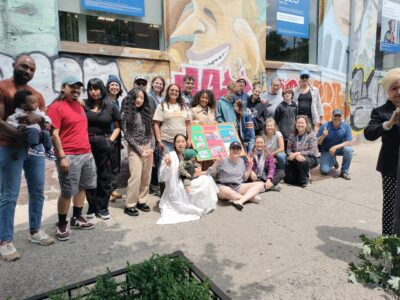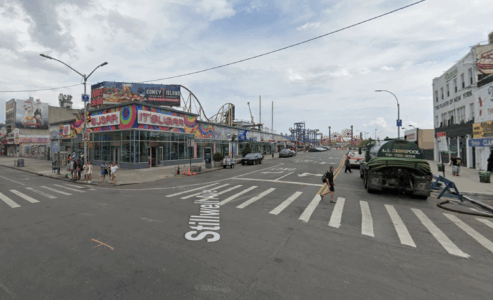CONEY ISLAND — Anti-violence programs across Coney Island are getting $850,000 in city funding to address an uptick in gun violence in the community, starting with gaps in social services.
The funding, announced Tuesday by Councilmember Mark Treyger, will focus on holistic approaches like education and access to social workers. The goal, the lawmaker said, is to back a more proactive approach as opposed to a reactive one.DAILY TOP BROOKLYN NEWSNews for those who live, work and play in Brooklyn and beyond
The 60th Precinct, which includes Coney Island, Brighton Beach, West Brighton Beach and Sea Gate, has seen 12 shooting incidents so far in 2019 as of Dec. 8. That number is up from just three last year, and five murders this year compared to none in 2018, according to NYPD data.
“We have a very holistic approach [here] to deal with public safety because, to me, you can’t look at things through silos,” Treyger said Tuesday at Liberation Diploma Plus High School. “What brought this together was, after each shooting, we did follow up with the 60th Precinct and other local law enforcement and we tried to find out what happened. But, what we also did was ask how could we be helpful and proactive — not just reactive.”
He and his colleagues found there was a connection between those who had committed shootings and those who had been through the criminal justice system.
“Literally almost every single person that has committed an act of shooting, or an act of violence, has been through the justice system before, over and over and over again,” Treyger said. “You cannot just simply police your way out of this issue. You cannot incarcerate your way out of this issue. You need to actually help people and address the roots.”
Treyger said Tuesday that he secured $550,000 in City Council discretionary funding with support from Speaker Corey Johnson. He said he also worked to secure an additional funding enhancement of $300,000 to expand the Crisis Management System, the mayor’s anti-gun violence initiative, throughout Coney Island.
The city’s allocation will add to a $250,000 grant from the state’s SNUG Neighborhood Violence Prevention Program for the Coney Island Anti-Violence Collaborative, a coalition of residents, business owners and organizations working together to end gun violence on the peninsula.
The new city funding will go toward continuing the efforts of local organizations including the Operation H.O.O.D. Cure Violence Initiative and the Collaborative, as well as national ones operating in the area: Center for Alternative Sentencing and Employment Services, the Center for Employment Opportunities, Opportunities for a Better Tomorrow, Family Preservation Services and Heart Share St. Vincent’s Services.
Operation H.O.O.D. — “Helping Our Own Develop” — aims to identify and mediate conflict among at-risk youth through mentorship and case management services. The group helps with housing, health care, social services and education, while promoting community norms that reject violence.
Derek Latif Scott, the director of Operation H.O.O.D., told the room Tuesday that his program’s violence interrupters have interrupted 117 violent acts so far this year. “We talk about trauma, but the trigger is pulled before the trigger is pulled,” Scott said. “What I mean by that is in so many cases, these adverse childhood experiences that exist within our household, within our neighborhood, that we turn a blind eye and deaf ear to.
“We need a lot of work to be done, we want change to happen,” Scott went on, “but, unfortunately, a lot of us aren’t looking in the mirror and saying ‘I want to become the change.’ We have to look in the mirror and say, ‘What am I doing to change the face of Coney Island?’ That’s what my team is doing.”
Many of the other programs assist individuals coming out of the justice system in finding jobs, building careers and achieving financial stability, as well as connecting them to education, health and social services.
“Every year, about 600,000 people return home [from incarceration] and, for the most part, they’re left to fend for themselves,” Derick Bowers, director of social enterprise at Center for Employment Opportunities said. “It’s very difficult for them, no matter how many policies we pass like banning the box on job applications, there’s still this huge stigma, these huge barriers that exist every day for those returning home.”
Bowers’ organization provides immediate — and paid — transitional employment at 26 locations across the country. “We know that that immediate payment really goes a long way for those who really have those barriers, who need to get up in the morning and get a MetroCard, print out a resume, buy a tie because how can we expect folks to do those things without those resources,” he said.
The neighborhood’s increase in shootings is an outlier in the precincts that make up Brooklyn South, where shootings overall are down 23 percent as of Dec. 8. Citywide, the number of shootings have slightly risen in comparison to 2018. That’s driven in part by a spate of mass shootings in other parts of Brooklyn.
Two mass shootings occurred over the summer — one in Crown Heights in which four people were killed and three injured, and one in Brownsville in which one man was killed and 11 others were injured.
Nearly two months ago, a shooting inside an unlicensed gambling club in Crown Heights left another four people killed and three injured.
“Coney Island, historically, has been very much been an under-resourced community, and that’s part of the reason why we’re facing some of the challenges that we are,” Treyger said. “Folks need help and they need support through appointments, through education, through social help services. We’re working to make sure Coney Island is never under-resourced again.”
Correction (4:30 p.m.): This article has been updated to remove incorrect statistics pertaining to NYPD Patrol Brooklyn Brooklyn North, the unit which oversees precincts in northern Brooklyn.

 Sunset Park residents look to form new mural at 54th Street
Sunset Park residents look to form new mural at 54th Street  Man charged with attempted kidnapping after allegedly grabbing six-year-old in Coney Island
Man charged with attempted kidnapping after allegedly grabbing six-year-old in Coney Island